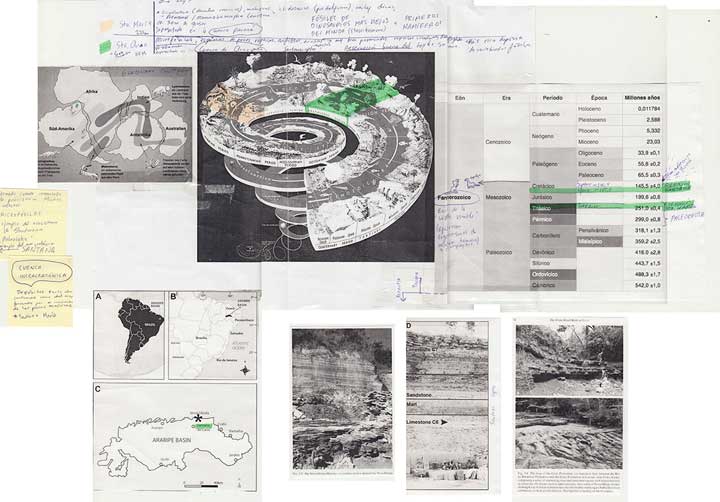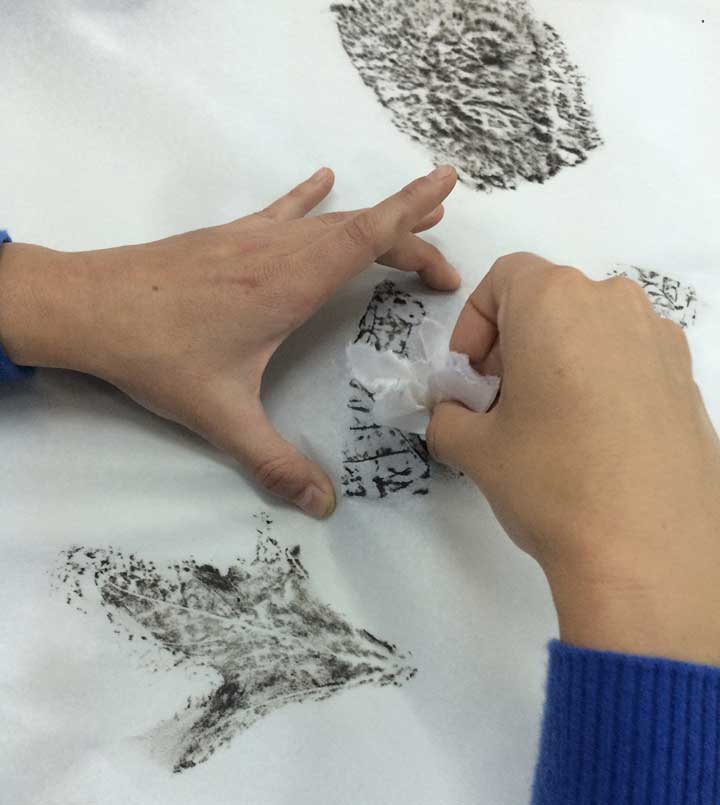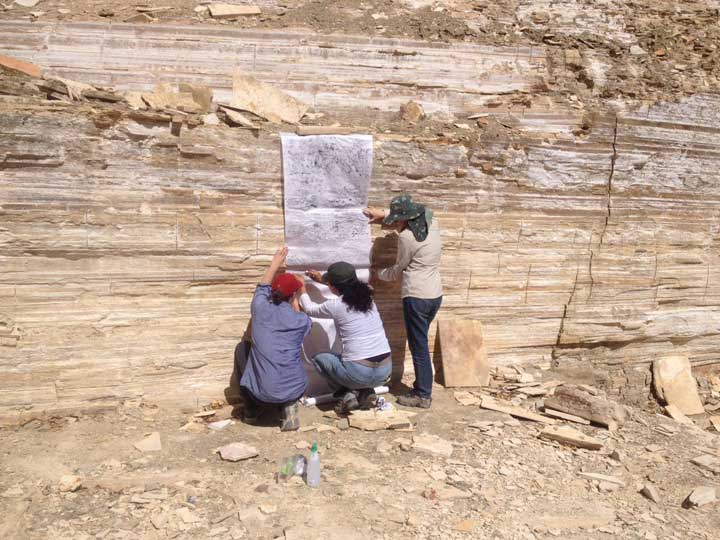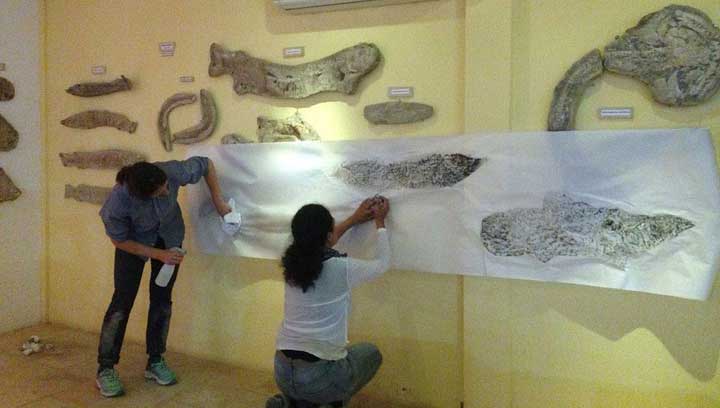Mariana Castillo Deball presents the studies behind Hipótese de uma árvore [Hypothesis of a Tree], installation created by the artist for the #32bienal:

Phylogenetic Tree
"Gabriela Aguileta, a very dear friend from school is an evolutionary biologist. Recently we had a conversation about her research, how the field of evolution has changed with technology, genetic research, and the development of phylogenetic trees. A phylogenetic tree or evolutionary tree is a branching diagram showing the inferred evolutionary relationships among various biological species or other entities—their phylogeny—based upon similarities and differences in their physical or genetic characteristics. Gabriela has a philosophical approach to biology, and we always end up talking about deep time. Last time I spoke to her I asked her, what is the relationship between paleontology—the study of fossils—, and what she does, which is based in genetic data? She told me that they are often in conflict and sometimes they even have contradictory theories about time. I found this very interesting and considered if it would be possible to put these two worlds together: the territory of tangible fossils that leave an imprint on stone, and the very ethereal and cybernetic study of genetic data. My idea for the biennale was based on this contradiction".

Solnhofen Museum: a recreation of a quarry workshop (left), and lithographic workshop (right)
"The journey began at the paleontology museum in Solnhofen, in southern Germany, which has an impressive collection of specimens found from the area, considered as a lagerstätte, a site containing fossil deposits extraordinarily preserved from the Jurassic period. The second floor of the Museum is dedicated to the German actor and play writer Johann Alois Senefelder (6 November 1771 – 26 February 1834) who was also the inventor of the lithographic printing process in 1796. The stones that Senefelder used for printing were from the same paleontological site in southern Germany, I though it was quite amazing that a non-human and a human recording process came from the same material and site".

Geometric structure sketches by Alberto Vivar Abascal, Studio Castillo Deball
"I wanted to build a 3-dimensional phylogenetic tree as a very dense space where the spectator could experience the huge diversity of species from the inside. Each of the branches of the phylogenetic tree would correspond to a specific species, and would be represented by an ink rubbing on large sheets of Japanese paper".

Scale model of “Hypothesis of a tree”, Alberto Vivar Abascal, Studio Castillo Deball

Paleontological collection, Naturkundemuseum, Berlin
"When I returned to my studio in Berlin, I arranged to meet with paleontologists Dr. Barbara Mohr and Dr. Florian Witzmann at the Museum of Natural History. The museum collects and preserves fossils and fossil replicas from Europe as well as internationally. There I learned more about the Crato Formation in Brazil, and I started to experiment with ink paper rubbings, to see how sensitive the technique is to capture the texture and structure of the actual fossils".

Merle Greene at work making one of her rubbings in Bonampak
"The technique that would be used for the piece was borrowed from Merle Greene an American archaeologist, who did extensive research in the Maya region. She recorded several monuments with her paper rubbing technique using Japanese paper and ink, completing around 5000 rubbings of Maya monuments. Surprisingly, this tactile exercise produced very clear images of the stone relief onto the paper; sometimes much more readable than the bare stone itself".

Crato Formation
"The Crato Formation, located on the northeast Brazil’s Araipe Basin is one of the most important paleontological sites in the world, with a great diversity. We traveled there to find fossils, and make rubbings".

In process of making an ink rubbing of a fossil at the the Cariri Regional University Paleontology Museum

Antônio Alamo Feitosa Saraiva, Juliana Manso Sayão and Renan Alfredo Machado Bantim at the Parque dos Pterossauros Geosite, Santana do Cariri, Ceará
"Most of the rubbings for the piece were made in the Ceará Cariri Region in northeastern part of Brazil, an important site with the largest Lagerstätte of the Cretaceous Period in Brazil. A combination of erosion and tectonic plate movement has brought a diverse cross-section of the area’s geological history relatively to the surface, allowing it to be studied by paleontologists and geologists. Fossilized species for a large part of the Animalia Kingdom of the phylogenetic tree structure could be found there. I was guided and advised by paleontologists Juliana Manso Sayão, Renan Alfredo Machado Bantim, Flaviana Jorge Lima and Antônio Alamo Feitosa Saraiva".

Limestone quarry at the Pedra Cariri Geosite, Ceará
"Some ink rubbings were made on-site, and geological elements were also included in the drawings, such as this limestone strata at the Pedra Cariri Geosite. Limestone from the Araripe Basin has been extracted and used in Brazilian civil construction since the nineteenth century. The natural limestone is arranged in thin layers of sediments, deposited by calms waters over 112 million years ago, capturing and preserving an abundant biodiversity. In recent years, a huge effort has been made to collect the fossils—including those from vertebrates, invertebrates, insects and plants—extracted from limestone quarries. These kinds of fossils are known as “Lagerstätte”, a sedimentary deposit that exhibits extraordinary fossils with exceptional preservation—sometimes including preserved soft tissues".

Fish fossils (Cretaceous Period, 110 M.A.) are commonly found between the layers of limestone at the Pedra Cariri Geosite, Ceará

Calcareous concretions removed from the excavation site, Parque dos Pterossauros
"A concretion is a hard, compact mass of matter formed by the precipitation of mineral cement that usually form early in the burial history of the sediment (110 M.A.), before the rest of the sediment is hardened into rock. Popularly known as “Pedra de Peixe” (fish stone) the concretions can sometimes also preserve three-dimensional macrofossils of pterosaurs, dinosaurs, turtles and plants".

Calcereous concretion containing crystallization and fossiliferous content (most likely fish), Parque dos Pterossauros Geosite

Work at the Cachoeira de Missão Velha Geosite, Município de Missão Velha, Ceará
"Rubbings were also made of ichnofossils or so-called “trace fossils”, like these which were left by worms in mudstone (Devonian Period, 420 M.A.)".

Petrified logs, Missão Velha Formation (Jurassic Period, 145 M.A.) found in the Floresta Petrificada do Cariri Geosite. Município de Missão Velha, Ceará
"During the Jurassic period, the area was covered by trees, similar to contemporary pine. Trees that fell into the river, and consequently became embedded in clay and mud fossilized into perfectly preserved fossils".

Rubbing in process at the Cariri Regional University Palaeontology Museum
"Many of the extracted and recovered fossils are on display at the University Museum, containing a large collection of bony fish, Santana Formation (Cretaceous Period, 110 M.A.), due to the regions contact to the Atlantic Ocean at that time".

Deposit at the Cariri Regional University Paleontology Museum

Fossilized Pterosaur wing (Cretaceous Period, 110 M.A.), Cariri Regional University Palaeontology Museum
"Evidence of at least 21 species of these giant reptilian birds have been found in the area".

Angiosperm specimen (Cratosmilax jacksoni) from the fossil registry of the Cariri Regional University Palaeontology Department (Cretaceous Period, 100 M.A.)
"Angiosperms only began to emerge at the end of the Cretaceous Period, making such well preserved fossils quite rare".

Institute of Geosciences at the University of São Paulo

Selection of specimens, Institute of Geosciences at the University of São Paulo
"Research and drawings continued at the Institute of Geosciences at the University of São Paulo under the expertise of the Professor of Paleontology, Luiz Eduardo Anelli. The university collection includes a large amount of original fossils, plaster and resin replicas and enlarged models of microscopic species".

A stone formation or “stromatolite” produced by cyanobacteria, Institute of Geosciences at the University of São Paulo
"Microscopic bacteria such as cyanobacteria created unique structures some dating from 3.7 billion years ago".

Resin and plaster casts of debated “Ediacaran” or “Vendian” biota fossils. Institute of Geosciences at the University of São Paulo
"The university collection carries replicas of the debated Ediacaran fossils (Ediacaran Period, 600 M.A.), organisms that resist conforming to a tree of life; it is not even established if they were animals, with suggestions that they were perhaps lichens, algae, protists known as foraminifera, fungi or microbial colonies, or a hypothetical intermediate between plants and animals".

Schematic map of the phylogenetic tree for the final sculpture
"As research and work proceeded—from Berlin to Crato and finally to São Paulo—some dilemmas emerged: some species never leave fossils behind (such as fungi), many are microscopic (i.e. bacteria, archaea, protozoa), and others evolved too recently to have left many fossils behind (flowering plants). Like in a strategy game, each scientist that assisted the work would help to adapt the map by adjusting the order, adding and removing species to adjust to the fossil collection on hand but would remain within the logic and physical constraints of the phylogenetic tree".

Installation in process by bamboo specialists, Bambu Carbono Zero
"The final work was a spiral bamboo structure, based on a phylogenetic tree, showing the evolutionary relationships among biological species. From the structure hang the series of paper rubbings of fossil sediments from the Crato formation (Chapada do Araipe), the Museum and Institute of Palaeontology from the Carirí Regional University, and the Institute and replica workshop from the Institute of Geosciences at the University of São Paulo, Brazil".


Hipótese de uma árvore [Hypothesis of a Tree], 2016
